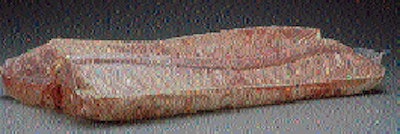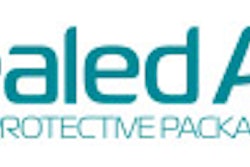Each year the Flexible Packaging Assn. honors companies whose achievements in advancing the art and science of flexible packaging deserve special recognition. This year's batch of winners included three special applications in the food industry that make it easier to transport food from one point to another. The first is a retort pouch.
Lighter, easier to dispose of, and less likely to cause handling injuries, the flexible pouch is becoming a popular replacement for the venerable #10 can in the foodservice industry. First for high-acid foods like ketchup or tomato sauce, and more recently for low-acid products like cheese sauces, aseptic filling systems have made it possible to substitute aseptic pouches for retorted cans in a variety of foodservice institutions.
But while suitable for sauces, aseptic processing is problematic for particulates. Retorting is usually required. Now, thanks to the efforts of American National Can (Chicago, IL), Multivac (Kansas City, MO), and Nature's Farm Products of Hayward, CA, retorted pouches of whole mushrooms in foodservice quantities are a commercial reality (1).
The technical challenge was two-pronged. First, ANC had to develop a foil-containing lamination capable of withstanding 250°F in a retort chamber without losing seal integrity; foil was selected as the most cost-effective barrier material. The lamination also had to meet requirements set by the U.S. Food and Drug Administration. For instance, the materials can't soften during the retort process, nor can the materials or the laminant migrate into the food during retorting. These requirements limit the number of materials that can be used.
The second part of the technological challenge was that the material also had to be formable. Otherwise the pouch would have to be premade, and premade pouches typically can't be filled at acceptable speeds.
ANC won't provide a material specification for the structure it developed for this award-winning package, other than to say it's a three-layer adhesive lamination with foil in the middle. According to ANC's Pat Dwire, similar technology has been used by the military for MRE (Meals Ready-to-Eat) pouches for several years now. But those are much smaller packages containing only 5 to 8 oz required for a single serving. The mushroom pouch now being produced by Nature's Farm weighs 100 oz or more, measures 12.5 x 13", and has a bottom cavity that's drawn 1.5" deep. That makes it a considerably more difficult pouch to make than the single-serve MREs, says Dwire.
Food and beverage manufacturer and distributor Nature's Farm packs the award-winning pouch at a plant in Chile. The material is cold-formed one-up at seven cycles per minute on a Multivac R5200 that incorporates plug assist to produce the necessary cavity in the forming web. The top web, which is heat sealed to its mate, does not get formed. The product is measured by an electronic scale system from Eagle Packaging Group (Oakland, CA).
Target customers include pizza restaurant chains, large food processors who use mushrooms in their products, and hotel, hospital and other foodservice sectors. According to Bob Berg, chief financial officer at Nature's Farm, such customers are very focused on controlling ingredient costs. They've made it clear they won't pay an upcharge for the pouch, even though it's a more expensive package to produce. So Nature's Farm will have to reduce its margins to market the pouch, says Berg. He won't quantify the reduction, "But you can use the word 'significant,'" he says.
"Right now we have an expensive package that isn't economically viable," continues Berg. "But that's partly because we started out with the surest possible materials."
Double-wall corrugated shippers for the pouches are particularly expensive, says Berg. "We simply could not afford any chance of a problem with the package," he continues. "What we now hope to do in our development work is scale back from these very conservative materials. But that's probably a one- or two-year exercise. Already we've prototyped a less costly pouch material. It forms well and it withstands the retort, but there's some peeling and cracking at the edges, so it needs some work."
Achieving a less costly package will have to involve Multivac as much as it does ANC, says Berg. Whether that means a new way of forming or moving away from heat sealing, Berg won't say. But the connection between machine and material is only logical, he says.
Vacuum packs for bone-in pork
Equally logical is the meat industry's use of vacuum packaging for transporting primals and subprimals to the nation's supermarkets. No other method so effectively protects and preserves fresh, moist meat.
Packers of bone-in pork, however, have been unable to take advantage of the benefits of vacuum packaging until recently. The main problem had been that the small sharp bones inherent in pork punctured vacuum packaging films easily so that leaker rates were unacceptable. Pork producers relied on vegetable parchment paper and a corrugated box or gas-flushed pouches shipped in corrugated containers.
Not anymore. The Cryovac Div. of W.R. Grace & Co. (Duncan, SC) recently developed special coextrusion technology and improved production methods to develop a barrier bag (2) with sufficient puncture resistance to withstand the sharp edges of bone-in pork. Typically enough, Cryovac is reluctant to provide material specifications beyond saying that nylon plays a significant role in providing the needed barrier and puncture-resistant properties. Called the Cryovac TBG bag, the package has brought pork producers longer shelf life while greatly reducing shrink and out-of-stock situations in the supermarket meat case.
Dave Heggestad, vice president of pork sales and marketing at Greeley, CO-based Monfort, Inc., was among the partners Cryovac relied upon as it developed its TBG film. He says that with parchment wrapping, a 13- to 22-lb bone-in pork loin is good for up to 10 days. A portion sliced from it and placed in the meat case has another 2 1/2 days before it must be marked down for sale. With a gas-flushed approach, says Heggestad, the same loin is good for up to 15 days and offers the same 2 1/2 days in the retail meat case. When vacuum packed the same loin is good for up to 28 days uncut, and a portion lasts 3 1/2 days in the supermarket meat case. "The retardation of microbial growth is that much better under vacuum packaging," he explains.
But Heggestad hastens to add that the extended shelf life isn't the real story behind TBG, because the fresh pork industry is geared for inventory turns much shorter than 30 days. The biggest benefit of vacuum packaged pork is improved product integrity. "The vacuum package does not allow the meat to be exposed to cold, dry air, so it does a much better job of preserving moisture content and color," says Heggestad. "And color is what moves meat." Also, because moisture retention is so much better, shrinkage is reduced by about 1%, says Heggestad.
As for reducing shrink in the meat case and minimizing out of stocks, these benefits stem directly from vacuum packaging's ability to extend shelf life.
"Shrink in the retail case is cut in half because you can slice meat as you need it," says Heggestad. "For example, if you have 20 pork loins in preparation for a special sale and for some reason the sale doesn't go well, you don't have to cut all 20 loins. You can keep what you need to in the cooler much longer than you could have with paper-wrapped or gas-flushed meat. Out of stocks are kept to a minimum, too. It used to be that if you needed 20 loins you might order a few less for fear that you might wind up with too much inventory and be forced to mark it down as the shelf life expires. Now, if you need 20, you order 20, and if sales are strong you still have enough inventory to prevent out of stocks."
Monfort's early development work on the vacuum packaging project took place in Marshalltown, IA. But the firm now has a Cryovac 8600B-16EL vacuum packaging machine, specially built with large chambers for the 28 to 40" loins, in each of its three pork plants. Operators load the loins into premade bags on a standard taped bag loader and then feed the bags to the vacuum packaging machine for evacuation and heat-seal closing.
Though Monfort pretty much pioneered the commercialization of the bag, Cryovac says that as of January 1995, 17 pork packers have installed or scheduled systems for vacuum packaged bone-in pork in almost two dozen plants. Cryovac also claims its TBG bag offers an 86.7% reduction in the weight of packaging materials used compared to gas-flush packaging of bone-in pork. Apparently the thickness and square footage of film required is greatly reduced when TBG is used and the corrugated spec can be downgauged considerably. Typically the loins are packed four per corrugated case.
Cost-wise, says Heggestad, the TBG bags are only marginally more expensive than other materials used in other methods of packaging bone-in pork, and the advantages are well worth the slight upcharge.
"When you start adding up the dollars saved, it's unbelievable," he points out.
Better shelf life for retail package, too
In the poultry industry came another FPA award-winning shelf life extension. This time it was for Cuddy Family Farms' boneless turkey breast tenderloins and ground turkey (3). (The Marshville, NC, firm was acquired by Broadway, VA-based Wampler-Longacre, Inc. in August of 1994, but within this article the name "Cuddy" will be used.)
Like other meat and poultry marketers over the past few years, the firm now packages its case-ready turkey cuts on foam trays in a modified atmosphere package produced on an Ossid (Rocky Mount, NC) tray wrapping system. Gas flushing and an unspecified 5-layer coextruded barrier film from Cryovac (Duncan, SC) allow Cuddy to guarantee at least a 10-day shelf life "from point of first receiver;" the "first receiver" in most cases is a central warehouse of a supermarket chain.
For proprietary reasons, Cuddy won't say just how long the shelf life is from date of packaging. But it's enough to give supermarket retailers plenty of time to turn the product before the sell-by date is up. "Most chains that are regular users of fresh case-ready poultry take two shipments per week into their warehouses, sometimes three," says Glen Carter, vp sales at Cuddy.
Unlike some marketers of fresh case-ready poultry who merchandise their product by means of high-impact graphics on a paperboard sleeve, Cuddy delivers its graphic pop right on the barrier film. The surface printing is done flexographically in six colors by The InterFlex Group (Ashland, VA).
Before its switch to modified-atmosphere unit packs, Cuddy was shipping its cuts on foam trays wrapped in nonbarrier films and gas-flushed in master packs. Carter says a chief advantage of the new method is that the hermetically sealed leak-proof package eliminates the wet package syndrome that so irks supermarket shoppers. He also likes knowing that each package has its own modified atmosphere and barrier film to preserve its shelf life. With the gas-flushed master pack, says Carter, once a case was opened the individual packs had no barrier or modified atmosphere to protect them. If they didn't sell in two days or so, they had to be marked down for quick sale.
Carter admits the barrier material does cost more than the tray wrap film used previously, but that's offset by the elimination of the master bag and the labor cost involved in gas-flushing it. The elimination of the bag also aids in Cuddy's efforts at source reduction.


























